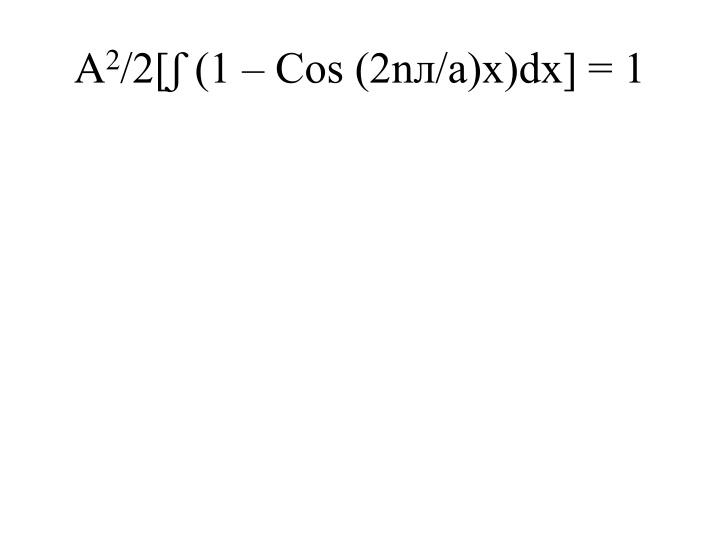
Quantum Mechanics: Particle Behavior in Three-Dimensional Space
Explore how particles behave in three-dimensional boxes through the time-independent Schrodinger equation. Understand the calculations of probabilities and energy levels for different scenarios. Dive into the mathematical representations and implications in quantum mechanics.
Download Presentation

Please find below an Image/Link to download the presentation.
The content on the website is provided AS IS for your information and personal use only. It may not be sold, licensed, or shared on other websites without obtaining consent from the author. If you encounter any issues during the download, it is possible that the publisher has removed the file from their server.
You are allowed to download the files provided on this website for personal or commercial use, subject to the condition that they are used lawfully. All files are the property of their respective owners.
The content on the website is provided AS IS for your information and personal use only. It may not be sold, licensed, or shared on other websites without obtaining consent from the author.
E N D
Presentation Transcript
Hence (x)= (2/a)1/2Sin (n x/a)x................................ (29)
solution. We can now calculate the probability of finding the particle at any point, x, once the values of n, x and a are known.
Note also that we can now calculate E for n equals two different values e.g. 2 and 3 from equation (28)
The probability is [(x,n)] so if the value of n, x and a are known, then it can be evaluated.
box. Here we want to expand the box to three dimensions. The particle is confined to a regular shape with sides of a, b, and c by having an infinite potential outside the box.
The time-independent Schrodinger equation for a single particle of mass m, moving in three dimensions is
(x,y,z)= E (x,y,z)................................................... .....................................(32)
Where the Hamittonian operator is = - ( 2/2m) 2 + V(x,y,z).................... (33)
And 2= d2/dx2+ d2/dy2+ d2/dz2..................................................... ................ (34)
The wave function is normalized so that (- x + ) = *(x,y,z) (x,y,z)dxdydz = 1..........(35)
If a particle can move in three dimensions, its probability density P(x,y,z) is given by
P(x,y,z)= *(x,y,z) (x,y,z)......................................... ...........................................................(3 6)
is between y + dy and the z coordinate is between z + dz is P(x,y,z)dxdydz = *(x,y,z) (x,y,z)dxdydz which can be shortened to * dT where dT represents the differential element of volume dxdydz.
zero, the following partial differential equation for the region inside the box is obtained as - 2/2m(d2/dx2+ d2/dy2+ d2/dz2) = E .................. (37)
If we assume that the wave function is the product of three functions each depending on just one coordinate we will have;
(x,y,z)= X(x)Y(y) Z(z)......................................................... ............................................... (38)
By substituting this for in equation (37) and then divide by X(x)Y(y)Z(z)we obtained
-2/2m(1/X(x)[d2X(x)/dx2] +1/Y(y)[ d2Y(y)/dy2] +1/Z(z)d2Z(z)/dz2])= E ......................... (39)
independent variable and this can be varied independently of one another, each must equal a constant in order that the sum of the three terms equals a constant for all values of x, y and z.
Ex+ Ey+ Ez= E............................................................ ................................................. (40)
This coverts the partial differential equation (39) into three ordinary differential equations that can be easily solved
-2/2m(1/X(x)[d2X(x)/dx2] = Ex........................................................... ............................. (41)
-2/2m(1/Y(y)[d2Y(y)/dy2] = Ey........................................................... .............................. (42)
-2/2m(1/Z(z)[d2Z(z)/dz2] = Ez........................................................... ................................. (43)
These equations are just like equation (27) and may be solved in the same way to obtain
X(x)= A(x)Sin nxx/a = A(x)Sin (2mEx/ 2)1/2x..................................................... ............ (44)
Y(y)= A(y)Sin nyy/b = A(y)Sin (2mEy/ 2)1/2y..................................................... ............. (45)
Z(z)= A(z)Sin nzz/c = A(z)Sin (2mEz/ 2)1/2z..................................................... ................. (46)
sides in the x, y and z directions respectively, nx, nyand nzare non-zero integers called quantum numbers and Ex = h2nx2/8ma2and so on.
each coordinate. When the wave function is normalized, we obtained (x,y,z)= (8/abc)2 Sin nx x/a Sin ny y/b Sin nz z/c ......................................... (47)
When the Eigen function is substituted in eqn (37) we obtained:
E = h2/8m(nx2/a2+ ny2/b2+ nz2/c2)..................................................... .......... (48)
independent and for a given set of three quantum numbers there is in general, a unique value for the a b c.
If the sides of the box are equal; if a = b = c, the energy levels are given by
E = h2/8ma2 (nx2+ ny2+ nz2)......................................................... ...... (49)
(with different wave function) make up a level that we can refer to as the 211 level. Such an energy level is said to be degenerate and the degeneracy is equal to the number of independent wave functions associated with a given energy level as shown below. Note that 111 level is non-degenerate.
nx, ny, nx111 211 221 311 222 321 322 411 331
Degeneracy 1 3 3 3 3 3 1 6 3
The degeneracy of a translational energy level increases rapidly with energy. If n2= nx2+ ny2+ nz2, the E = h2/(8ma2). n2
and nzalong the z-axis, then n can be taught of as the length of a vector in this three dimensional space. All such vectors with the same length have the same energy they represents degenerate states.
